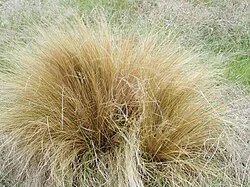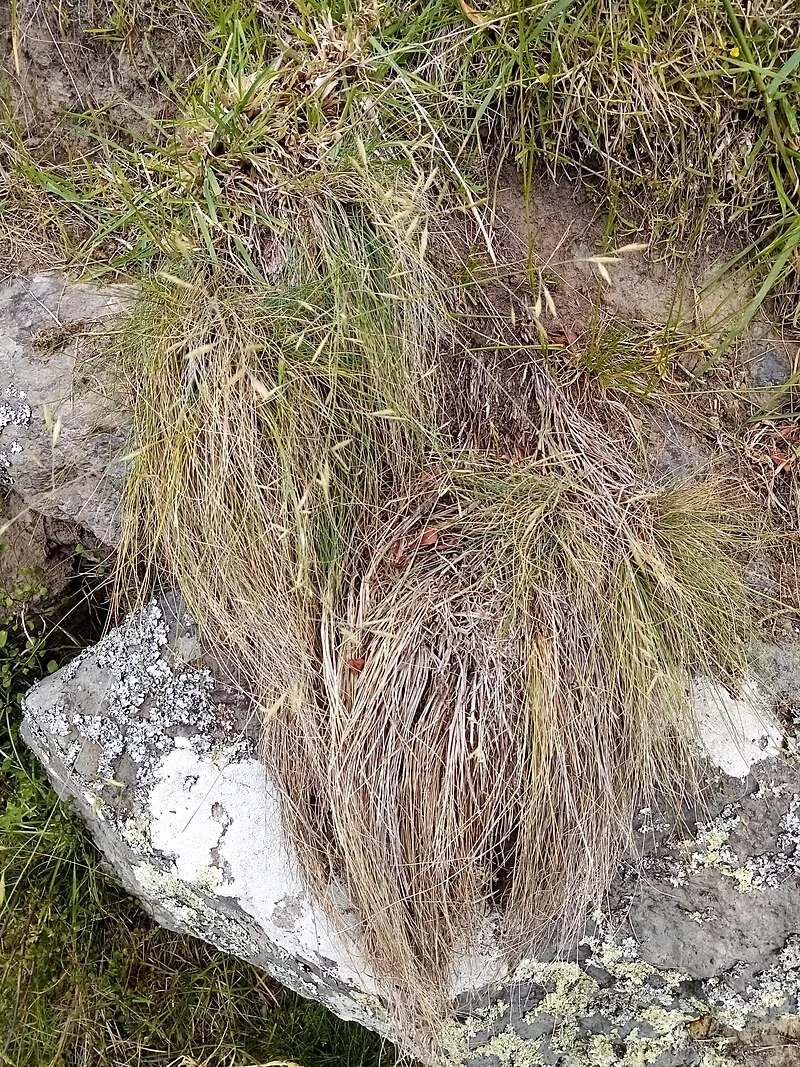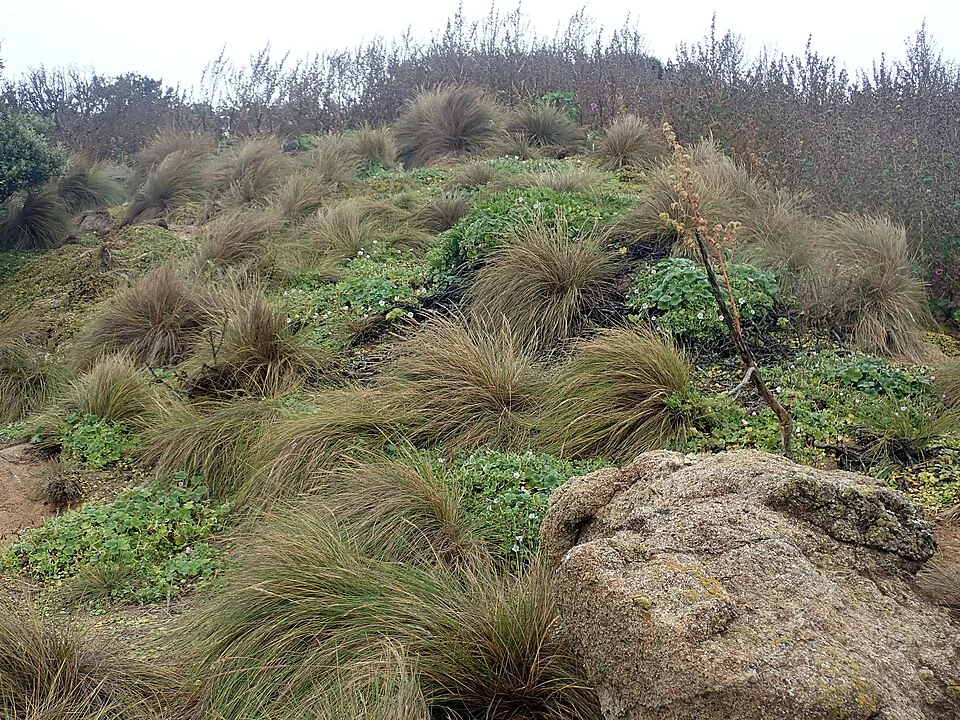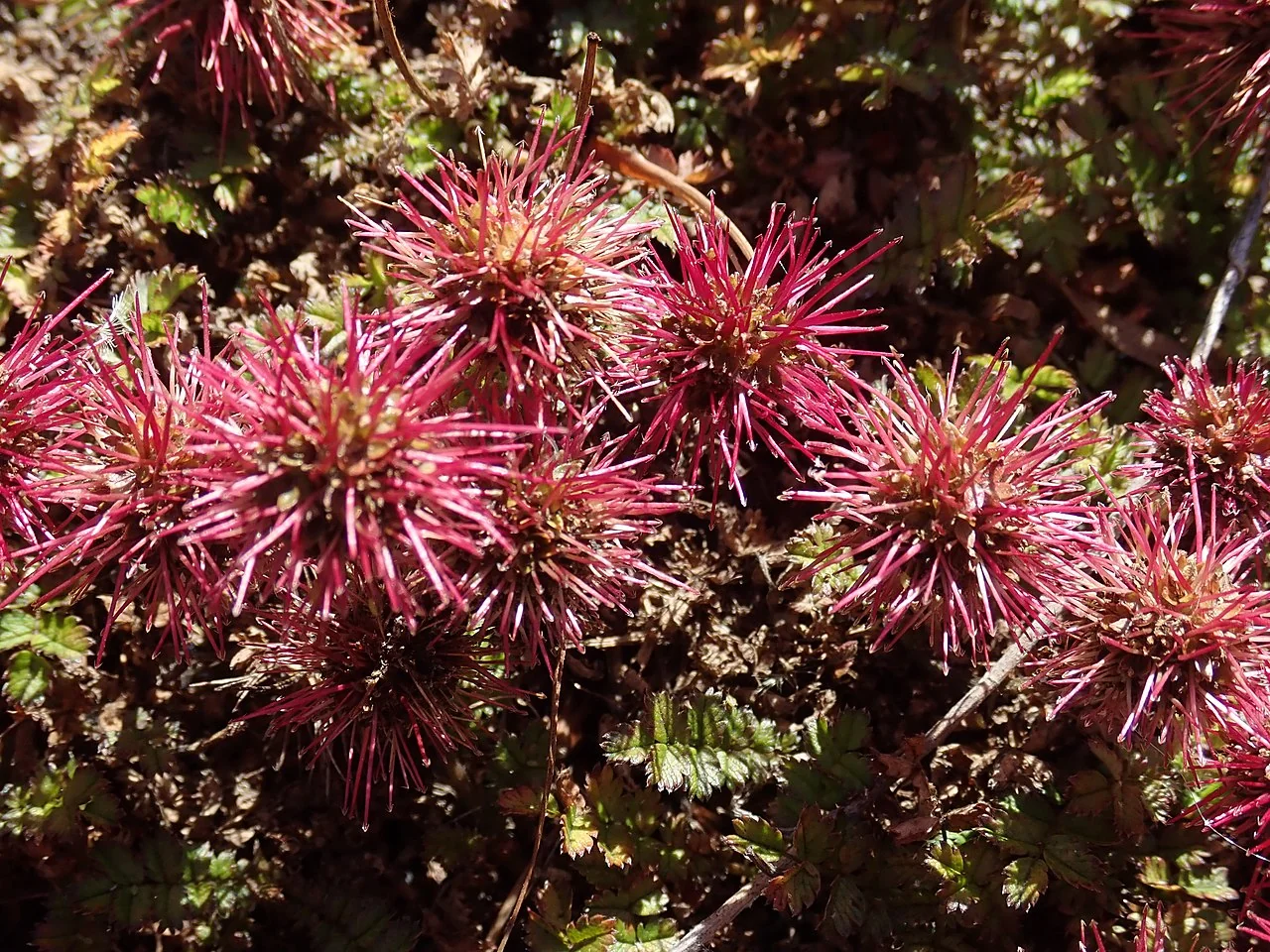
Hard Tussock
Festuca novae-zelandiae
Explore more NZ native plant guides in our index .
Introduction
About Hard Tussock
Festuca novae-zelandiae , commonly known as Hard Tussock or New Zealand Fescue, is an iconic native grass that forms the backbone of many of New Zealand's distinctive tussock grasslands. This robust, perennial bunchgrass creates dense, upright tussocks with fine, wiry leaves that range from green to golden-brown, depending on the season and growing conditions. Naturally occurring across the South Island's eastern ranges and central regions, Hard Tussock is superbly adapted to harsh, exposed conditions with extreme temperature variations and periodic drought, making it invaluable for ecological restoration and low-maintenance landscaping in challenging environments.

Plant Description
Botanical Features
Festuca novae-zelandiae , commonly known as Hard Tussock or New Zealand Fescue, is a long-lived, caespitose (growing in dense tufts) perennial grass native to New Zealand. It forms dense, upright tussocks with fine, wiry leaves that range from green to golden-brown, depending on the season and growing conditions. The leaves are delicate, 15-60 cm long, 0.5-1 mm wide, rough to the touch, and have sharply pointed tips, with margins tightly in-rolled, giving them a cylindrical appearance. Flowering stems can reach up to 70 cm tall and bear an open flowering panicle 5-12 cm long during summer. This species is a common component of low tussock grasslands, particularly in the dry, windy, and cold plains of Canterbury and Otago, thriving in temperate biomes from sea level up to 800-900 meters in alpine areas. It is a hardy and resilient grass that tolerates poor soil, dry conditions, frost, and wind, and is drought-tolerant, requiring little maintenance once established.
Quick Facts
Overview
| Scientific Name | Festuca Novae Zelandiae |
|---|---|
| Height | 30-60 cm |
| Spread | 40-80 cm |
| Water Needs | Low to moderate |
| Light | Full sun |
| Frost Tolerance | Excellent |
| Salt Tolerance | Moderate |
| Growth Rate | Slow to moderate |
| Lifespan | Long-lived perennial |
Climate Best Suited to
Hard tussock dominates dry hill and montane grasslands in eastern and central Aotearoa. It thrives in regions with cold winters, hot summers, and low to moderate rainfall, provided soils are free-draining.
Regional Suitability
| Whangārei | Ideal |
| Auckland | Ideal |
| Hamilton | Suitable |
| Rotorua | Suitable |
| Tauranga | Ideal |
| Gisborne | Ideal |
| New Plymouth | Ideal |
| Whanganui | Ideal |
| Palmerston North | Suitable |
| Napier | Ideal |
| Wellington | Ideal |
| Nelson | Ideal |
| Christchurch | Suitable |
| Dunedin | Suitable |
| Invercargill | Suitable |
| City | Climate Suitability |
|---|
Natural Habitat
Festuca novae-zelandiae , also known as fescue tussock or hard tussock, is a perennial grass native to New Zealand. It is commonly found in low tussock grasslands across the dry, windy, and cold central plains, particularly in the Canterbury and Otago regions of the South Island. This species is also present in New Zealand's alpine and subalpine regions.
Historically, short tussock grasslands, dominated by Festuca novae-zelandiae and silver tussock (Poa cita), covered significant areas of the eastern South Island, from sea level up to elevations of 800-900 meters. It is a resilient grass that tolerates poor soil, dry conditions, frost, and wind. It often grows on steep, exposed slopes and in alpine areas at lower altitudes, it can be associated with the narrow-leaved snow tussock (Chionochloa rigida).
Plant Conservation
Festuca novae-zelandiae , also known as fescue tussock or hard tussock, is classified as "Not Threatened" in its current conservation status as of 2017 and 2023 assessments. This status has remained consistent in previous assessments from 2004, 2009, and 2012. It is a native and endemic vascular grass to New Zealand.
Growing Requirements
Soil Requirements
Requires free-draining, often stony or loess soils. Avoid rich, wet sites which reduce longevity. Excellent for poor, droughty ground and slopes.
- Gravelly/sandy loams; low fertility
- Strong aversion to waterlogging
Light Requirements
Full sun is essential for dense, upright form and good tussock colour.
Water Requirements
Very drought-tolerant when established. Water sparingly; excess summer irrigation encourages lax growth.
Planting Guide
Festuca novae-zelandiae , also known as New Zealand Fescue, hard tussock, or fescue tussock, is a hardy, evergreen, native New Zealand grass that forms dense, mounding tufts. It's well-suited for dry, open landscapes and challenging conditions, making it a popular choice for low-maintenance landscaping, erosion control, and revegetation projects.
1. Site Selection and Soil:
- Sunlight: Plant in full sun for the best growth and foliage colour.
- Soil: It thrives in well-drained soil and tolerates poor, sandy, or rocky soils. It prefers free-draining soil rich in organic matter.
- Tolerances: Festuca novae-zelandiae is highly tolerant of frost, drought, coastal conditions, and wind.
2. Planting:
- Timing: While it can be planted year-round, spring and autumn are ideal as they allow the plant to establish roots before summer heat.
- Spacing: Space individual plants about 30-40 cm apart to allow for natural spread and good airflow.
-
Preparation:
- Ensure the plant's rootball is moist before planting. If dry, immerse it in water until air bubbles stop.
- For new gardens, dig over the site to remove weeds and grass, then add compost or fertilizer.
- For individual plants, clear an area of about 600mm to 1 m diameter around the planting spot.
-
Method:
- Dig a hole twice the depth and width of the plant's root ball.
- Mix compost and sheep pellets into your existing soil at a 50/50 ratio.
- Place the plant so the top of the root ball is level with the surrounding ground, creating a slight depression to capture water.
- Tease out the roots if necessary and spread them in the hole.
- Backfill the hole, firming gently but not compacting the soil.
- In heavier clay soils, plant onto a raised mound and add gypsum clay breaker to the bottom of the hole to improve drainage.
- Watering after planting: Water thoroughly after planting.
3. Care and Maintenance:
- Watering: Water during establishment, but once established, reduce watering as it prefers drier conditions. All watering should be thorough rather than frequent.
- Fertilizing: It generally doesn't require fertilizer. However, blood and bone or slow-release fertilizer tablets can be mixed with backfill or added to the hole at planting time.
- Pruning: Remove dead or old foliage annually in late winter to maintain its tidy form. Remove spent foliage in the spring.
- Division: Clumps may need to be divided every 2-3 years to maintain their appeal.
- Mulching: Mulching around the base of the plants (avoiding direct contact with the plant base) helps conserve moisture, regulate soil temperature, and reduce weeds. Options include stones, wet newspapers, cardboard, old wool carpet, weed mats covered with straw, bark chips, or compost.
- Pests and Diseases: This species is generally pest- and disease-free.
4. Propagation:
- Festuca novae-zelandiae can be easily grown from fresh seed.
- Seeds germinate without pre-treatment.
- Sow seeds directly and keep them moist until germination is complete.
- It is preferable to propagate by seeds rather than cuttings or division to maintain genetic diversity.
5. Characteristics:
- Appearance: It has a mounding habit, forming tight, uniform tufts. The very narrow leaves are blue-green to dark green, turning tan in early autumn. The needle-thin, erect leaves can range from green to blonde.
- Size: Typically grows to 30-45 cm tall and 30-40 cm wide, but can reach up to 70 cm in height and 0.4 m in spread.
- Bloom Time: Flowers in August (in the Southern Hemisphere). Flowering stems can reach up to 70 cm tall.
- Grass Type: Cool Season Grass, meaning it grows primarily in early spring and again in the fall, potentially going dormant in warmer summer months.
Ecological Role
Environmental Benefits
Festuca novae-zelandiae , also known as New Zealand fescue or hard tussock, plays several significant ecological roles in its native New Zealand ecosystems:
- Soil Stabilization and Erosion Control: Its tufted growth habit and deep root system are crucial for stabilizing soil, particularly on steep, exposed slopes and in mountainous environments, thereby helping to control erosion.
- Habitat and Food Source: This grass provides essential habitat for various native fauna, including birds, insects, and lizards. It also serves as a forage source for native herbivores.
- Dominant Grassland Component: Festuca novae-zelandiae is a common and often dominant species in low tussock grasslands, especially in the dry, windy, and cold plains of Canterbury and Otago.
- Resilience and Adaptability: It is highly resilient and adaptable, thriving in challenging conditions such as poor soil, limited moisture, drought, frost, and wind. This hardiness makes it a persistent feature in the landscape.
- Revegetation Efforts: Due to its ability to tolerate adverse conditions, it is considered an excellent species for revegetation and restoration projects.
- Ecological Association: In lower alpine regions, Festuca novae-zelandiae is frequently found growing alongside the narrow-leaved snow tussock (Chionochloa rigida).
- Historical Range Expansion: The species has seen a dramatic expansion in its range over the 1000 years of human settlement in New Zealand and was historically a major component of short tussock grasslands across the eastern South Island.
- Unpalatability: Being relatively unpalatable, Festuca novae-zelandiae has, in some instances, increased in prevalence and displaced more palatable species due to pastoral farming practices.
Uses and Significance
Provides essential structural habitat in native tussock grasslands, creating protective microclimates for numerous invertebrates, native lizards including skinks, and ground-nesting birds such as pipit and skylark. The dense tussock base offers shelter and nesting sites, while the fine seed heads provide food resources for granivorous birds. This keystone species helps maintain the complex ecological relationships that characterize New Zealand's distinctive high-country ecosystems.
Landscape Uses
Mass planting for dry landscapes, erosion control on banks, and low-input revegetation.
Cultural Significance
Traditional Uses and Values
Festuca novae-zelandiae , commonly known as New Zealand fescue or hard tussock, holds cultural significance primarily through its integral role in the New Zealand landscape and ecosystem. It is a native and endemic species to New Zealand, particularly prevalent in the low tussock grasslands of the dry, windy, and cold plains of Canterbury and Otago in the South Island.
While specific traditional Māori uses for Festuca novae-zelandiae are not widely documented, its widespread presence as a dominant grass in these grasslands means it has been a consistent feature of the environment for both Māori and later European settlers. These tussock grasslands were historically significant, providing a certain amount of food for introduced stock, and the new growth after burning was acceptable to stock.
Ecologically, Festuca novae-zelandiae is valued for its hardiness, drought tolerance, and ability to thrive in poor soils, making it important for erosion control and revegetation projects. Its fine, tufted foliage forms dense mats, contributing to soil stabilization, especially in mountainous environments, and it provides habitat for alpine wildlife. The plant's resilience and adaptability to challenging conditions have made it a recognized and integrated part of the unique New Zealand flora.
Landscaping Uses
Festuca novae-zelandiae , also known as New Zealand Fescue, Native Fescue, fescue tussock, or hard tussock, is a versatile native grass with several landscaping applications.
Key Landscaping Uses ForFestuca Novae-Zelandiae Include:
- Mass Planting: It is commonly mass-planted on banks to create a stunning display and is an excellent choice for uniform coverage and textural contrast.
- Modern Gardens: It is frequently incorporated into modern garden designs.
- Contrast: Its tawny foliage provides an effective contrast with darker-foliage plants.
- Erosion Control and Revegetation: Due to its hardiness, deep roots, and ability to form dense mats, it is well-suited for erosion control, especially on steep, exposed slopes, and for native revegetation projects.
- Borders and Edging: It can be used for bordering or edging in gardens.
- Challenging Conditions: This resilient grass thrives in dry, open landscapes, tolerates poor soils, frost, wind, and extended dry periods, making it ideal for coastal gardens, rocky outcrops, and areas with limited moisture.
- Low-Maintenance Landscapes: Once established, it requires little maintenance, making it perfect for low-input or naturalistic landscapes.
- Specific Garden Styles: It is suitable for various garden styles, including architectural, backyard, city and courtyard, coastal, frontyard, Japanese, Mediterranean, modern, native, and rock gardens.
- Other Uses: It can also be used in living areas, around paths and steps, and in pool areas.
Festuca novae-zelandiae typically grows to around 30-45 cm tall and 30-40 cm wide, forming tight, upright tussocks. It is attractive to insects and lizards.
Seasonal Care Calendar
Spring
Remove winter-burnt foliage; divide large clumps if needed.
Summer
Minimal watering; avoid over-fertilising.
Autumn
Plant/divide to establish before winter; tidy dead leaves.
Winter
Tolerates frost; ensure drainage remains sharp.
Pruning and Maintenance
Techniques and Timing
Comb out dead thatch and accumulated leaf litter with gloved hands in late winter or early spring, working gently to preserve the tussock's natural architecture. Avoid hard cutting or trimming which can permanently disfigure the distinctive dome shape and reduce the plant's drought tolerance. Light grooming helps maintain air circulation and reduces fire risk while preserving the characteristic golden-brown coloration that provides year-round landscape interest in native tussock plantings.
How to Grow Hard Tussock
Hard Tussock is an iconic native grass that forms the backbone of New Zealand's distinctive tussock grasslands. This robust, perennial bunchgrass is superbly adapted to harsh, exposed conditions with extreme temperature variations and periodic drought, making it invaluable for ecological restoration and low-maintenance landscaping in challenging environments. Its fine, wiry leaves and upright growth habit create attractive, tawny-coloured tussocks that provide year-round texture and interest. Understanding its propagation methods is key to successfully growing this resilient species.
From Seed
Propagating Hard Tussock from seed is a reliable and effective method. Collect mature seed heads in late summer when they turn golden-brown and the seeds can be easily shaken free. Store the seeds in cool, dry conditions until sowing in autumn or early spring. Sow the seeds onto the surface of a well-draining, gritty seed mix without covering them, as light aids germination. Maintain the substrate lightly moist but never waterlogged, as excess moisture can cause seed rot. Germination typically occurs within 14-28 days under suitable conditions, with seedlings developing slowly but establishing strong root systems characteristic of this drought-tolerant species. Once seedlings have developed a few true leaves, they can be potted into individual containers and grown in a sheltered location before planting out.
From Division
Established clumps of Hard Tussock can be easily divided, especially in late winter or early spring when the plants are dormant. This method is excellent for rejuvenating older, overgrown plants and for creating new plants that are genetically identical to the parent. Use a sharp spade to divide the dense root mass into manageable sections, ensuring each division retains both fibrous roots and several growing points. Replant the divisions promptly into free-draining soil, spacing them appropriately to allow for their eventual spread. Water thoroughly after planting and keep consistently moist until established. This method preserves the genetic characteristics while rejuvenating older clumps that may have developed dead centers.
Pests and Diseases
Festuca novae-zelandiae , also known as New Zealand Fescue or Native Fescue, is generally considered to be pest- and disease-free, making it a low-maintenance choice for gardens in New Zealand. It is a hardy native tussock grass that thrives in dry, open landscapes and tolerates poor soils.
Potential Pests:
While Festuca novae-zelandiae itself is noted for its resistance, some general insect pests in New Zealand grasslands can affect tussock species, including:
- Grass grub (Costelytra zealandica): The larvae of this endemic insect feed on roots and can infest large areas of pasture land, including native tussock grasslands.
- Porina moth complex (Wiseana spp.): These are also endemic insects whose caterpillars initially live on the soil surface and then tunnel underground, feeding on roots.
- Leaf-eating insects: Various species of Lepidoptera larvae, such as those from the genera Crambus, Persectania, and Leucania, have been observed to feed on tussock leaves.
- Root-feeders: Besides grass grubs and porina, other root-feeding insects like Odontria species have been recorded attacking tussock.
Diseases:
Diseases specifically impacting Festuca novae-zelandiae are rarely reported; the species is generally regarded as hardy. However, general grass seed crops in New Zealand can be affected by various diseases, including:
- Foliage diseases: Crown rust (Puccinia coronata), anthracnose (Colletotrichum graminicola), and leaf scald and leaf spots caused by various fungi can affect tillering and seed head development.
- Seedling diseases: Soil-borne fungi like Pythium and Fusarium species can cause diseases at establishment.
- Seed head diseases: Stem rust (Puccinia graminis var. graminis), ergot (Claviceps purpurea), blind seed disease (Gloetinia temulenta), choke, bacterial wilt, and head smut (Ustilago bullata) can affect seed heads.
It's important to note that these general grass diseases and pests are more commonly associated with intensive pastures of introduced species like ryegrass and clover, which are more vulnerable to destructive invasive pest species. Festuca novae-zelandiae , being a native species, is generally more resilient.
Bonus Tip
Expert Growing Advice
Festuca novae-zelandiae , the Hard Tussock, is a true survivor of New Zealand's challenging landscapes! Its fine, wiry leaves are not just for show; they are tightly in-rolled, giving them a cylindrical appearance that helps reduce water loss in dry, windy conditions. This clever adaptation allows it to thrive in harsh environments where many other plants would struggle. It's also a master of disguise; its foliage can range from green to golden-brown, changing with the seasons and growing conditions, adding subtle, natural beauty to the tussock grasslands.







